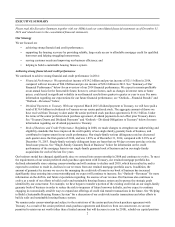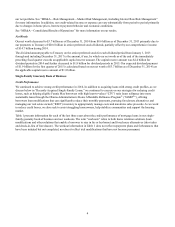Fannie Mae 2014 Annual Report Download - page 17
Download and view the complete annual report
Please find page 17 of the 2014 Fannie Mae annual report below. You can navigate through the pages in the report by either clicking on the pages listed below, or by using the keyword search tool below to find specific information within the annual report.12
and economic and housing market conditions. Our expectations for our future financial results do not take into account the
impact on our business of potential future legislative or regulatory changes, which could have a material impact on our
financial results, particularly the enactment of housing finance reform legislation as noted in “Uncertainty Regarding our
Future Status” above.
As noted under “Dividend Obligations to Treasury” below, under the terms of the senior preferred stock, our capital reserve
will decline by $600 million each year until it reaches zero in 2018. Although we expect to remain profitable on an annual
basis for the foreseeable future, due to our declining capital reserve, our expectation of substantially lower earnings in future
years than our earnings for 2014, and the potential for significant volatility in our financial results, we could experience a net
worth deficit in a future quarter, particularly as our capital reserve approaches zero. If that were to occur, we would be
required to draw additional funds from Treasury under the senior preferred stock purchase agreement in order to avoid being
placed into receivership. See “Risk Factors” for a discussion of the risks associated with our declining capital reserves.
Revenues. We currently have two primary sources of revenues: (1) the guaranty fees we receive for managing the credit risk
on loans underlying Fannie Mae MBS held by third parties; and (2) the difference between interest income earned on the
assets in our retained mortgage portfolio and the interest expense associated with the debt that funds those assets. Our
“retained mortgage portfolio” refers to the mortgage-related assets we own (which excludes the portion of assets held by
consolidated MBS trusts that back mortgage-related securities owned by third parties). In recent years, an increasing portion
of our net interest income has been derived from guaranty fees rather than from our retained mortgage portfolio assets, due to
the shrinking of our retained mortgage portfolio and the impact of guaranty fee increases. We estimate that the portion of our
net interest income derived from guaranty fees on loans underlying our Fannie Mae MBS increased from more than one-third
in 2013 to approximately half in 2014. We expect that guaranty fees will continue to account for an increasing portion of our
net interest income.
The decrease in the balance of mortgage assets held in our retained mortgage portfolio contributed to a decline in our net
interest income and revenues in 2014 as compared with 2013. We expect continued decreases in the size of our retained
mortgage portfolio, which will continue to negatively impact our net interest income and revenues; however, we also expect
increases in our guaranty fee revenues will partially offset the negative impact of the decline in our retained mortgage
portfolio. We expect our guaranty fee revenues to increase over the long term, as loans with lower guaranty fees liquidate
from our book of business and are replaced with new loans with higher guaranty fees. The extent to which the positive impact
of increased guaranty fee revenues will offset the negative impact of the decline in the size of our retained mortgage portfolio
will depend on many factors, including: changes to guaranty fee pricing we may make in the future, including any directive
we receive from FHFA to change our guaranty fee pricing; the size, composition and quality of our guaranty book of
business; the life of the loans in our guaranty book of business; the size, composition and quality of our retained mortgage
portfolio, including the pace at which we are required by our conservator to reduce the size of our portfolio and the types of
assets we are required to sell; economic and housing market conditions, including changes in interest rates; our market share;
and legislative and regulatory changes.
Dividend Obligations to Treasury. We expect to retain only a limited amount of any future net worth because we are required
by the dividend provisions of the senior preferred stock and quarterly directives from our conservator to pay Treasury each
quarter the amount, if any, by which our net worth as of the end of the immediately preceding fiscal quarter exceeds an
applicable capital reserve amount. This capital reserve amount is $1.8 billion for each quarter of 2015 and continues to
decrease by $600 million annually until it reaches zero in 2018.
As described in “Legal Proceedings” and “Note 19, Commitments and Contingencies,” several lawsuits have been filed by
preferred and common stockholders of Fannie Mae and Freddie Mac against the United States, Treasury and/or FHFA
challenging actions taken by the defendants relating to the senior preferred stock purchase agreements and the
conservatorships of Fannie Mae and Freddie Mac, including challenges to the net worth sweep dividend provisions of the
senior preferred stock. We cannot predict the course or the outcome of these lawsuits, or the actions the U.S. government
(including Treasury or FHFA) may take in response to any ruling or finding in any of these lawsuits.
Overall Market Conditions. We expect that single-family mortgage loan serious delinquency and severity rates will continue
their downward trend, but at a slower pace than in recent years. We expect that single-family serious delinquency and
severity rates will remain high compared with pre-housing crisis levels because it will take some time for the remaining
delinquent loans with high mark-to-market LTV ratios originated prior to 2009 to work their way through the foreclosure
process. Despite steady demand and stable fundamentals at the national level, the multifamily sector may continue to exhibit
below average fundamentals in certain local markets and with certain properties.
We forecast that total originations in the U.S. single-family mortgage market in 2015 will increase from 2014 levels by
approximately 7% from an estimated $1.19 trillion in 2014 to $1.28 trillion in 2015, and that the amount of originations in the
























